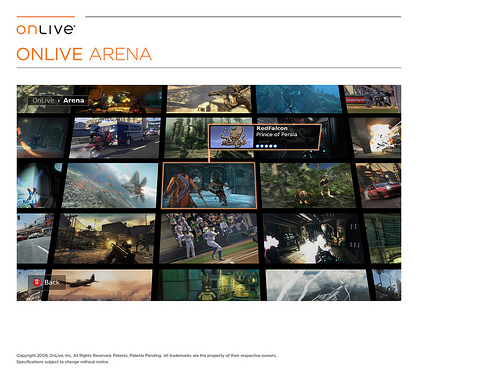By Joel Smart (The Cascade) – Email
Print Edition: November 30, 2011
In last week’s column, I wrote about the way dedicated cloud-saving has become a new and innovative development in the way user data is preserved – with plenty of potential to change the way games are played. While these future features are likely to come next generation, when cloud saving will likely be built into each device’s infrastructure, there is another way the cloud is being used to revolutionize gaming – and it’s happening as we speak. OnLive uses the cloud (internet) to stream games directly to computers, TVs and mobile devices, all without requiring hard drive space to save the game. It functions like an on-demand movie service, but for full-sized, mainstream games.
Although the service is subscription-based, and requires users purchase a small “micro-console” and a wireless controller for $99, it promises to be simpler and faster way to game than that offered by other gaming devices. You never have to change a disk or wait for a download. According to the OnLive website, the service then costs $10 per month for players to become active members of the service. However, to actually play a game, players must additionally pay a rental or ownership fee on each game. A common price-point for active OnLive members is $5 for a three-day rental, $7 for five days, and $50 for a full ownership – so long as the game remains on the OnLive service and the player remains an active member of the service. Does this mean that if players fail to pay a single month that they will lose all of the games they had purchased? It’s tough to say, but it seems like a risky venture.
It’s tough to say just how good or bad of a service OnLive really is. It seems a little over-priced, especially considering players lose access to every game they’ve paid for once they stop subscribing to the service. However, ability to use the service everywhere—on PC, Mac and Android computers and tablets, as well as on the TV—makes it a very versatile gaming option.
While it seems unlikely that many will invest in the service at this point, the current availability of such an option means we are heading closer and closer towards the future of gaming.
Though, upon closer review, it actually seems a little disheartening. Although I quite like the idea of cloud saving, I wouldn’t like it if I could no longer save a hard copy of my data should I wish to stop using a service. With OnLive, I can tell that I would feel the need to keep paying $10 per month forever, to avoid feeling as though I had thrown a bunch of money down the drain. When you purchase a disk or a downloadable game, it is yours forever – at no extra cost. That is a model I don’t want to move away from, even if it does mean greater convenience. I have enough monthly subscriptions to worry about without having to pay a company to keep all of my games online for me.
While I find OnLive intriguing, I think it will need to be bundled with Netflix and offered with unlimited games per month for a single low price to be successful. Even still, I think a physical copy of a game will always truly feel safer, especially since I can still play my games when my internet stops working. Maybe I’ll reconsider if Steam offers a similar service some day—since they always seem to keep the gamers’ priorities first—but until then, I think I’ll leave the cloud for game saves alone.


